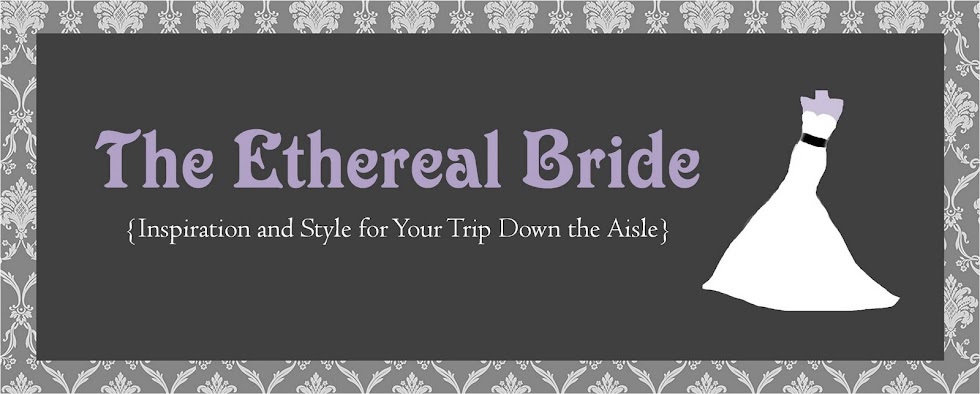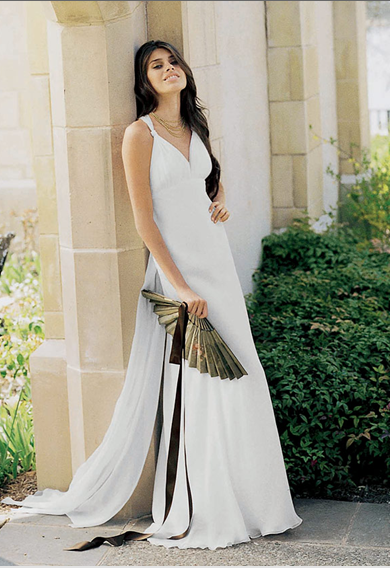First of all, there are two aspects of fabric that you need to understand- how it's made and what it's made of. How it's made refers to whether or not it's knit or woven and what type of knit or weave it is. Typically, most special occasion fabrics are woven, except for some stretch jersey, so I'll just focus on that. The way a fabric is woven determines how it feels to the touch and how it flows on the body. Some examples of different types of weaves are satin, taffeta, and organza. What it's made of refers to what type of fibers were used to make the fabric. Some examples are cotton, silk, acetate, linen, and polyester. Sometimes a combination of fibers is used such as a silk/cotton blend. Below, I will discuss the most common fabrics in greater detail.
Polyester Satin
Most people have horrible 1970's flashbacks when they think of polyester, but it's actually super versatile and probably the most common fabric used in the bridal industry. Shocking, I know. Poly satin is a super common satin because it looks very similar to silk satin but is way less expensive, more wrinkle resistant, and way less delicate. Keep in mind, there are many different quality levels of poly satin. There is a difference between a $99 poly satin gown and a $1900 one.
Pros: Less expensive than silk, more wrinkle resistant than natural fabrics, comes in any color, durable
Cons: Not as rich looking or feeling as silk satin, heavy and can be hot to wear
Best time of year to wear: Fall, winter or spring, however, it can defintely be worn in summer also just note that you may get overheated during an outdoor ceremony or photos.
Polyester satin gown by Allure Bridals; style# 8759
Polyester Chiffon
Like poly satin, poly chiffon is the most common type of chiffon in the bridal market. It is characterized by it's sheer, flowy look.
Pros: Less expensive than silk chiffon, lightweight, comes in any color
Cons: Wrinkles easily but not as easily as silk, delicate
Best time to wear: During warmer weather months
Polyester chiffon gown by David's Bridal; style# 9743
Taffeta
Taffeta is often made of a number of different fibers- nylon, acetate, silk or polyester. It is characterized by it's swishy and sometimes wrinkled texture. The stiffer the taffeta, the better the quality. To test the quality, scrunch a handful of the fabric, if it stays somewhat scrunched then it is good quality, if it springs back to being flat, then it is of lesser quality. Unlike other synthetic fabrics, certain synthetic taffetas are sometimes even better quality than silk taffeta, such as the Enzoani style featured below.
Pros: Lightweight, looks good if it's a little wrinkled, can come in any color, durable, synthetic varieties can be less expensive than silk (but not always), because of the way it's woven it can come in iridescent (almost two tone) colors
Cons: Not as lustrous as satin, some don't like the "swish" sound it makes
Best time of year to wear: Taffeta is perfect anytime of year because it's rich enough for winter months but lightweight enough for the hottest months
Iridescent crinkle taffeta dress by Bari Jay; style# 933
Nylon taffeta gown by Enzoani; style "Brie"
Silk taffeta gown by Jasmine Couture; style# T939
Silk Satin
Silk satin (sometimes referred to as peau de soie or duchesse) is probably the richest fabrics due to it's lustrous appearance and buttery soft feel. Unfortunately, it is also one of the most expensive. Just to give you a little perspective of just expensive silk satin is- at my local fabric retailer silk taffeta costs $25 per yard whereas the silk satin costs $75 per yard. However, in my esteemed opinion, it's worth every penny.
Pros: Very luxurious look and feel, much more lightweight than poly satin
Cons: Very expensive, not as durable as poly satin, heavier than some other fabrics, like all silk fabrics it can't come in stark white because silk can't be safely bleached without ruining the integrity of the fabric
Best time of year to wear: Probably best in cooler monts but can be worn anytime of year, just be aware that you may become overheated during outdoor summer ceremonies
Silk duchesse satin gown by St. Pucchi; style# 9322
Silk Organza
Organza is basically a stiffer chiffon; it is just as sheer but not really flowy. It also comes in poly or nylon, but I am only going to talk about silk organza because it is much more common and many of the properties are similar.
Pros: Luxurious, lightweight,
Cons: Wrinkles easily, delicate, expensive but not as expensive as silk satin
Best time of year to wear: Typically during warmer months, however, can really be worn anytime of year
Silk organza gown by James Clifford; style# J11009S
Dupioni Silk & Silk Shantung
Dupioni silk and silk shantung are very similar fabrics, so I'm just going to lump them together. They are both a plain weave using raw silk yarns (other silk fabrics' yarns are processed to give them their silky texture), the only difference between the two is that the yarns used in dupioni silk are "slubbed", which means the yarn's thickness is inconsistant, creating a uniquely textured fabric.
Pros: Fairly lightweight, rich look and feel, comes in lots of gorgeous bright colors, maintains volume without lots of crinolines underneath
Cons: Wrinkles pretty easily, expensive, some don't like the "raw" texture
Best time of year to wear: Anytime of year because it is lightweight enough for warm months but rich enough for cold months
Verbena silk shantung dress by Watters; style# 4912
Midori dupioni silk dress by Watters; style# 6456
Silk Charmeuse
Silk charmeuse, also sometimes referred to as "crepe backed satin" is a form of silk satin, but is super thin and flowy. It is primarily used in body conscious styles with lots of draping.
Pros: Super luxuious feel and look, less expensive than silk satin, drapes and flows really easily
Cons: Very delicate, more expensive than synthetic fabrics,
Best time of year to wear: Warmer months but can work during cold months because of it's rich appearance
Silk charmeuse gown by Vera Wang; style "Cassandra"
Silk charmeuse dress by Melissa Sweet; style# MS321
Tulle
Most people know tulle as the fabric commonly used in tutus, but it is also used in wedding gowns as well. It is characterized by it's stiffness, sheerness, and ability to create really full skirts. It is typically made of nylon but can also made of silk.
Pros: Lightweight, fairly inexpensive, hides wrinkles fairly well
Cons: Delicate, too poofy for some tastes, not as rich looking as other fabrics
Best time of year to wear: Anytime of year
Flower girl dress with tulle skirt by Johanna Grace; style# "Arabesque"
Tulle gown by Impression; style# 3073
Silk Chiffon
Silk chiffon (also known as silk mousseline or silk crinkle chiffon) is very similar to synthetic chiffon. It is sheer and very lightweight.
Pros: Lightweight, soft texture
Cons: Very delicate, expensive, some don't like it's raw texture
Best time of year to wear: Warm months
Silk mousseline dress by Watters; style# 4017B
{Images via their respective websites}
Want to know what the deal is with other fabrics?? Ask me in the comments section below!!















Hello there, Please tell me if Dupioni silk is the most expensive of all the silks. I am reading so much about silk that now I am confused. thanks so much...email is dela_c8@yahoo.ca
ReplyDeleteI have recently fallen head over heels for an oscar de la renta dress made of Silk Radzimir fabric (apparently imported from Italy). I want to have my seamstress try to make a similar style with the same fabric, but I have never heard of it, and the local fabric store doesnt have it. What's another similar silk fabric I can use in it's place? Are you familiar with this fabric? Thank you.
ReplyDeleteYou would probably want to go with another mid-weight silk fabric like silk taffeta or silk shantung. These have a similar look and feel, but are much more readily available. You wont necessarily find them at chain fabric stores (JoAnn, Hancock) but most specialty fabric stores and some online retailers will carry them. When ordering fabric online, always try and order a swatch first. That way you can make sure you like it before ordering several yards. Good luck!!
ReplyDeleteThank you so much for this post! I am having my dress made custom in silk fabric. I have been researching the different sub-types of silk, and most websites only have written descriptions. The photos you have included are extremely helpful! <3
ReplyDeleteI made a top with chiffon just to try it out and next time I will definitely use gelatine. Who'd have thought - brilliant. Thanks for sharing.......
ReplyDeleteSilk Chiffon Fabric NYC
Silk Organza Fabric NYC